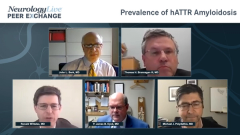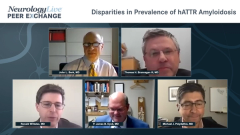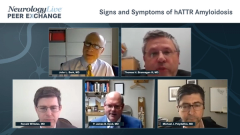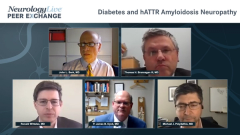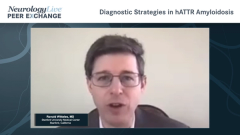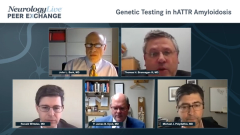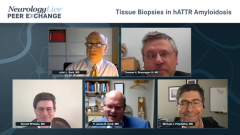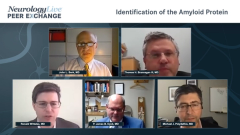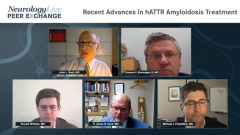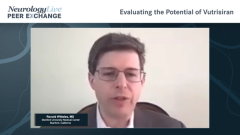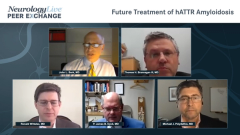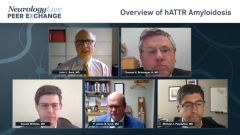
Tissue Biopsies in hATTR Amyloidosis
Various types of biopsies to diagnosis hereditary ATTR amyloidosis are discussed.
Episodes in this series

John L. Berk, MD: All 4 of you have talked about the diagnosis of disease and the avenues that you pursue. Dr Witteles, can you give us your perspective on the need for tissue and what’s your favorite?
Ronald Witteles, MD: Sure. On the cardiac side, most of the time we can make this diagnosis without tissue as long as they don’t have monoclonal protein and they clearly have a positive PYP [pyrophosphate] scan. After you have made the diagnosis, now all you need to do is genetic testing to determine if they have a wild type or a hereditary form of the disease. If either the PYP scan is equivocal or there’s a monoclonal protein, then you have to move on to biopsy. My own general preference is to biopsy the clinically involved organ, which in my world is the heart. Doing so in good hands has a very low risk. It’s much safer than, say, a kidney biopsy. Unlike other infiltrative cardiomyopathies, it has nearly 100% sensitivity and specificity. What’s more is that you will get lots of amyloid there, so you can accurately subtype it and make sure you’re making the right diagnosis.
It is reasonable if places want to start with a fat-pad biopsy first because it is even lower risk and easier to do; it can be done in the office. However, it has a much higher false negative result rate, particularly in ATTR [transthyretin-mediated amyloidosis] as opposed to AL [amyloid light-chain amyloidosis]. If you’re ever going to do that and it comes back negative, you have to follow it up with further testing such as an endomyocardial biopsy.
John L. Berk, MD: All right, neurologists. Dr Polydefkis, you spoke about epidermal nerve fiber analysis and skin punch biopsies. Can you give us your perspective on sural nerve biopsies?
Michael J. Polydefkis, MD: Sural nerve biopsies are fantastic; they pick up amyloid. It’s not 100% clear with cases with amyloid where it’s missed on a sural nerve biopsy, but it’s an excellent technique. If you have a high suspicion and you have a negative result, as Dr Witteles said: You don’t stop there. You would go further, whether that’s a skin biopsy, cardiac biopsy, fat pad biopsy, or other nerve biopsy; that is up for discussion.
John L. Berk, MD: Dr Brannagan, sural nerves. Do you do them?
Thomas H. Brannagan III, MD: I would say I do them. One situation that we do them not so much is somebody that we say has a gene test that then we want to confirm whether they have amyloid. Very often we do them when somebody has a significant or severe neuropathy, and we are trying to figure out why they have neuropathy. Amyloid is 1 cause of a severe neuropathy, vasculitis is another, CIDP [chronic inflammatory demyelinating polyneuropathy] is another for which we can usually identify a nerve conduction. Very frequently I’ve seen patients who are identified with amyloid because of the nerve biopsy and then we do the genetic testing.
If somebody has a mild, say, small fiber neuropathy and has a genetic test, I’m not always keen to jump straight to a sural nerve biopsy, which does have some morbidity. I would more likely do a skin biopsy that might show amyloid and also often can help document the presence of a neuropathy. Sometimes we do fat-pad biopsies, even though the sensitivity for ATTR is poor; I think it is in the 40%-to-50% range. I do sural nerve biopsies in some situations but not in all situations.
John L. Berk, MD: Way out in Minnesota, Dr Dyck?
P. James B. Dyck, MD: As the head of the Peripheral Nerve Research Pathology laboratory, I have very strong feelings about this topic, and it’s near and dear to my heart. I am much more dependent on pathology than most of my colleagues here. We have a nice service run through the Department of Hematology at the Mayo Clinic where they do fat aspirates, we call them, as an easy test and essentially every patient who walks into my door with peripheral neuropathy gets a fat aspirate. It’s part of my routine work-up for peripheral neuropathy. I’m using that both for AL and for TTR [transthyretin]. I also will do a monoclonal protein study in all patients who walk through my door. I have not done genetic testing on all my patients, but I have started to do it at a higher and higher frequency.
I agree with Dr Brannagan that fat aspirate has a low sensitivity. At our institution it’s 50% to 60%. On the other hand, because it is not a very invasive procedure, I do it on most patients, realizing that I may miss patients. You asked about sural nerve biopsy. I do biopsy where there is involvement. If you have a general polyneuropathy, the sural nerve is a good thing; but in some amyloids it’s a multifocal process, and I will often do a targeted fascicular nerve biopsy from an MRI lesion. That’s much more likely in AL than it is in TTR, so it’s a bit of a different topic. However, I don’t restrict myself to sural nerve biopsies and look because, I often will use it with imaging. Then we do lip biopsies as well, which I don’t think we’ve mentioned, as well as epidermal nerve fibers. Salivary glands are another good tissue to go after.
John L. Berk, MD: Parenthetically, can TTR amyloid can have associated myopathy in your experience, Dr Dyck?
P. James B. Dyck, MD: Thank you for asking that. We’ve recently written a paper about coexisting TTR myopathy. Yes, you can do a muscle biopsy too. However, the TTR myopathy is much less frequent than the TTR neuropathy.
John L. Berk, MD: Thank you for watching this NeurologyLive® Peer Exchange. If you enjoyed the content, please subscribe to our e-newsletters to receive upcoming Peer Exchanges and other great content right in your in-box.
Transcript Edited for Clarity
Newsletter
Keep your finger on the pulse of neurology—subscribe to NeurologyLive for expert interviews, new data, and breakthrough treatment updates.

